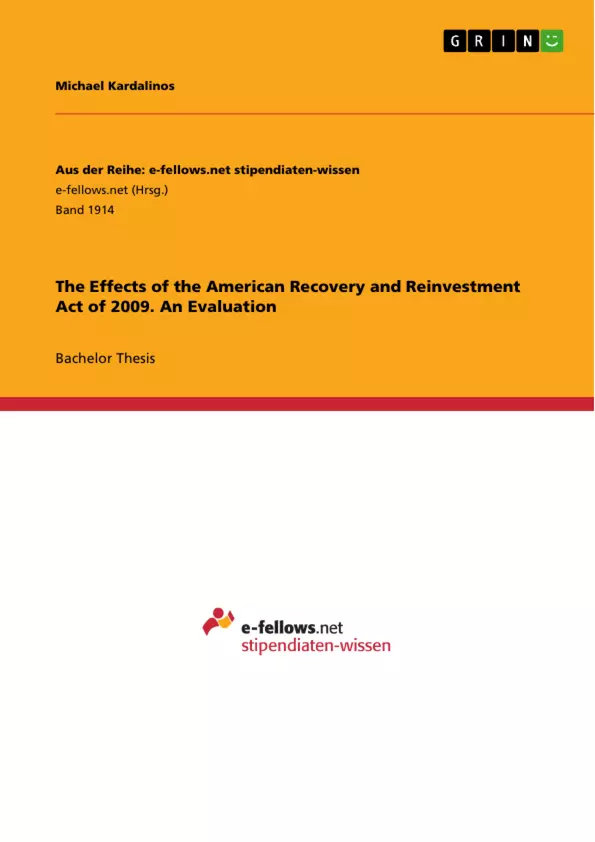The paper analyses the impact of the American Recovery and Reinvestment Act of 2009 (ARRA) to answer the question whether the stimulus was an appropriate crisis response.
This is done by looking at the official purposes of the Act, namely, Job creation and promotion of economic recovery, assisting those most impacted by the recession, state and local government budget stabilization and long-term investments. It is an interesting read for everyone who wants to know more about the effectiveness of deficit spending during the Great Recession.
Inhaltsverzeichnis (Table of Contents)
- Abstract
- 1. Introduction
- 2. Analysis of the ARRA purposes
- 2.1 Job Creation and Promotion of Economic Recovery
- 2.2 Assisting Those Most Impacted by the Recession
- 2.3 State and Local Government Budget Stabilization
- 2.4 Long-term Investments to Increase Economic Efficiency
- 3. Conclusion
- 4. References
Zielsetzung und Themenschwerpunkte (Objectives and Key Themes)
This paper evaluates the impact of the American Recovery and Reinvestment Act of 2009 (ARRA) in response to the economic recession, specifically focusing on whether the stimulus package was an effective crisis response. This is achieved by critically analyzing the official purposes outlined in the ARRA and examining whether the stimulus was successful in achieving its objectives.
- Job Creation and Economic Recovery
- Assisting Vulnerable Groups and Income Inequality
- State and Local Government Budget Stabilization
- Long-term Investments in Economic Efficiency
- Effectiveness of Keynesian Government Intervention
Zusammenfassung der Kapitel (Chapter Summaries)
Chapter 1, the introduction, establishes the context of the ARRA by highlighting the shift from neoclassical and neoliberal economic policies to Keynesian ideas in response to the global financial crisis of 2007-2008. It details the key features and cost of the ARRA and notes the ideological debate surrounding its implementation.
Chapter 2 analyzes the individual purposes of the ARRA. It examines the impact of the stimulus on job creation, poverty reduction, income inequality, and long-term economic investments, referencing various research studies and their findings. The chapter also explores the role of state and local government budget stabilization and the challenges associated with balancing short-term economic recovery with long-term structural improvements.
Chapter 3, the conclusion, synthesizes the findings of the paper and discusses the overall effectiveness of the ARRA in fulfilling its stated purposes. It concludes that the stimulus played a significant role in driving the US economy out of recession, highlighting its successes in job creation and poverty reduction while acknowledging its limitations in addressing income inequality and optimizing long-term investments.
Schlüsselwörter (Keywords)
The main keywords and focus topics of this work are: American Recovery and Reinvestment Act (ARRA), economic recession, Keynesian economics, job creation, economic recovery, poverty reduction, income inequality, state and local government budgets, long-term economic investments, infrastructure, economic efficiency, stimulus package, government intervention.
- Quote paper
- Michael Kardalinos (Author), 2016, The Effects of the American Recovery and Reinvestment Act of 2009. An Evaluation, Munich, GRIN Verlag, https://www.grin.com/document/335093



